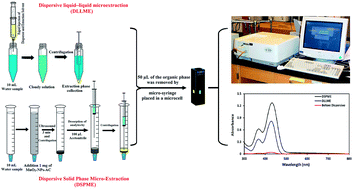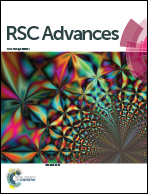Comparison between dispersive liquid–liquid microextraction and ultrasound-assisted nanoparticles-dispersive solid-phase microextraction combined with microvolume spectrophotometry method for the determination of Auramine-O in water samples
Abstract
Novel dispersive solid phase micro-extraction (DSPME) and dispersive liquid–liquid micro-extraction (DLLME) combined with spectrophotometry is designed for the preconcentration and/or determination of Auramine-O (AO) content in various real samples. DSPME is based on the application of manganese dioxide nanoparticles loaded on activated carbon (MnO2-NPs-AC). This new material was fully identified and characterized with FT-IR, FESEM, EDX and XRD analysis. Influence of variables, such as: different solid phase extraction sorbents; the type and volume of extracting solvent; sonication time; dispersive solvents; centrifugation time; and ionic strength (NaCl concentration) on response properties were optimized by Central Composite Design, response surface methodology and desirability function using STATISTICA. Optimum conditions was set for DSPME as: 1 mg MnO2-NPs-AC; 3 min sonication time; and 100 μL volume of extraction at pH 6.5. Meanwhile for DLLME conditions were fixed at: pH 6.5; 5 min centrifugation time; 0.035 mol L−1 NaCl concentration; and 140, 1000 μL and 10 mL of extraction solvent (CHCl3), disperser solvent (ethanol) and sample volume, respectively. Under optimum conditions, the method has linear calibration curves over the range from 10–1000 ng mL−1 and 1–2000 ng mL−1, with R2 = 0.9997 for DLLME and 0.9998 for DSPME, while the corresponding detection limits for DSPME and DLLME were 2.836 ng mL−1 and 0.232 ng mL−1, respectively. The relative standard deviation and enrichment factor were less than 4% (n = 10) and 99.93 for DLLME and 117.66 for DSPME, respectively. The experimental results were compared with those obtained by the use of DLLME and DSPME. The full procedures were applied for the preconcentration and subsequent determination of AO in wastewater, tap water, rain water and river water.


 Please wait while we load your content...
Please wait while we load your content...